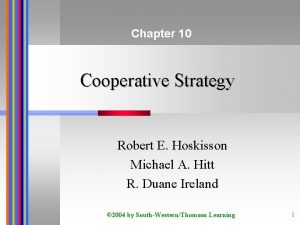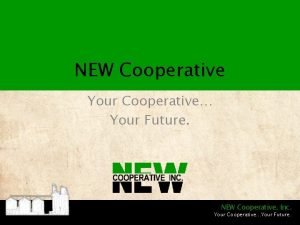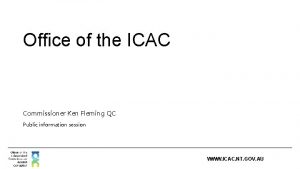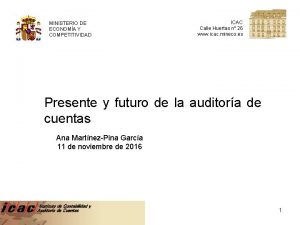13 th Meeting of the ICAC InterRegional Cooperative



















































- Slides: 51

13 th Meeting of the ICAC Inter-Regional Cooperative Research Network on Cotton for the Mediterranean and Middle East Regions EVALUATION OF DIFFERENT WEED CONTROL METHODS IN COTTON FIELD Md. Fakhre Alam Ibne Tabib, Ph. D Deputy Director

INTRODUCTION BANGLADESH COTTON: CURRENT SCENARIO • 2 nd largest apparel producer in the world • 2 nd largest cotton fibre consumer in the world • Highest Raw cotton importer in the world with 6. 25 million bales annual requirment-10. 30% of world import • Fibre Imports from-India, Uzbekistan, USA, Egypt, CIS and some African countries • 31. 50 billion US dollar business in 2016 expected creep up to 50 billion dollar in 2021

COTTON SECTOR IN BANGLADESH A. READYMADE Garments unit GARMENTS Total Work Force B. TEXTILE Knit wear industries Weaving mills Hand loom C. SPINNING Spinning mill D. GINNING Ginning Centres E. OIL EXTRACTION 5000 5. 5 million 1700 1343 0. 3 million 407 Private-20, CDB-12 Saw ginning 104 Roller ginning 25 Crude oil expeller 15 Oil refinery 01

Growing Season of Upland Cotton (Kharif-2) July Land Preparation & Sowing Crop Management Harvesting Aug. Sept. Oct. Nov. Dec.

Growing Season of Upland Cotton (Rabi) Nov. Dec. Jan. Feb. Mar. Apr. May. Land Preparation & Sowing Crop Management Harvesting

Major weeds commonly found in the cotton field Weed species Common Name Local Name Family Bermuda grass Nut Sedge Goose grass Ageratum conyzoides Goat weed Panicum repens Torpedo grass Digitaria sanguinalis Scrab grass Cyanotis axillaris Kanainala Commelina Spider wort benghalensis Durba Mutha Chapra Chaglagacha Banchina Angulighash Kanainala Kanaibashi Gramineae Cyperaceae Gramineae Compositae Gramineae Commelinaceae Azonopus compressus Karpetghash Cynodon dactylon Cyperus rotundus Eleusine indica Carpet grass

Farmers Practice - Manual Weed Control 1. Inc r hig ease 2. h Un labo produ a lab vaila ur pri ction 3. b o c cos Do ur fo ility o e. t du esn r f c e to agr con ’t p e. i c t e ultu we rol d rfor ral mt ath u ime er c e to ond unfa ly w e itio vou n. rab ed le

Farmers Practice - Chemical Weed Control 1. 2. Glyp Hig hos h c ate m ort rop bas 3. No alit inj ew u y t eed ry sta feas. a nd co ge ibl s e of eed ntro co duri lin l. tto ng g np see lan t. dling

OBJECTIVES • To select economical and suitable weed control method for controlling weeds in cotton field. • To evaluate the weed control efficiency of different weed control methods.

Experiment-1 Efficacy of Different Herbicides Over Manual Weeding in Controlling Cotton Weed

METHODS AND MATERIALS Design : RCBD No. of replication: 3 Treatments: T 1= Weedy control T 2= Hand weeding T 3= Glyphosate @ 3. 5 L ha-1 14 DBS of cotton T 4= Paraquat @ 2. 8 L ha-1 14 DBS of cotton T 5= Glyphosate @ 3. 5 L+ Paraquat @ 2. 8 L ha-1 14 DBS of cotton T 6= Orthosulfamuron @ 0. 15 g ha-1 14 DAS of cotton (Protective spray) T 7= Indazifalam @ 0. 15 L ha-1 14 DBS of cotton T 8= Phenoxyprop-P-Ethyle @ 0. 75 L ha-1 14 DAS of cotton (Protective spray) T 9= Cyhalophob-butayl @ 1. 0 L ha-1 14 DAS of cotton (protective spray) T 10= Bispyribac sodium@ 0. 15 g ha-1 14 DAS of cotton(protective spray) Date of sowing: 01 September, 2013 Cotton variety : CB-9

T 1 T 4 T 7 T 2 T 5 T 8 T 3 T 6 T 9

RESULTS AND DISCUSSION

Initial weed No. /m-2 Weed No. /m-2 at 55 DAS Weed Wt. at 25 DAS (g) 350 Weed No. /m-2 at 25 DAS Initial Weed Wt. (g) Weed Wt. at 55 DAS (g) 45 300 40 250 35 30 200 25 150 20 15 100 10 50 5 0 0 T 1 T 2 T 3 T 4 T 5 T 6 Treatments T 7 T 8 T 9 T 10 Fig 1. 1: Weed abundance as influenced by different herbicide application and manual weed control Weed weight (g) Weed number ( No. /M-2) 50

WCE 25 DAS WCE 55 DAS Weed Control Efficiency (WCE) 100 90 80 70 60 50 40 30 20 10 0 T 2 T 3 T 4 T 5 T 6 T 7 Treatments T 8 T 9 T 10 Fig. 1. 2: Weed control efficiency of different herbicides and manual weeding

Table 1. 1: Plant count and morphological characters of cotton as influenced by different herbicide application and manual weeding Treatment T 1 T 2 T 3 T 4 T 5 T 6 T 7 T 8 T 9 T 10 LSD 0. 05 CV% No. of plant/ha 22500 24550 23180 23320 24280 19070 3429 21260 17830 18110 3375 9. 96 Sympodial br/ plant 7. 33 7. 80 8. 10 7. 23 8. 46 6. 50 1. 83 7. 30 7. 63 8. 90 1. 76 14. 45 Monopodial br/ plant 1. 30 1. 20 0. 87 0. 90 1. 03 0. 37 1. 70 1. 07 1. 10 0. 395 21. 49

T 1 T 6 T 2 T 7 T 3 T 8 T 4 T 9 T 5 T 10 90 80 Plant height (cm) 70 60 50 40 30 20 10 0 Plant height at 25 DAS Plant height at 55 DAS Plant height at harvest Fig 1. 3: Plant height of cotton as influenced by different herbicide application and manual weed control

Table 1. 2: Yield and yield components of cotton as influenced by different herbicide application and manual weeding Treatment Seed Cotton Yield Kg ha-1 No. of boll plant-1 Single boll wt (g) T 1 384. 1 13. 60 5. 30 T 2 1289. 0 17. 23 5. 96 T 3 1207. 0 16. 40 5. 80 T 4 1008. 0 17. 00 4. 53 T 5 1211. 0 19. 60 6. 27 T 6 912. 2 16. 30 5. 60 T 7 144. 0 3. 633 1. 67 T 8 761. 3 16. 37 6. 13 T 9 925. 9 16. 50 5. 87 T 10 939. 6 14. 30 5. 77 LSD 0. 05 173. 00 3. 85 1. 63 CV% 11. 48 14. 86 17. 91

Table 1. 3: Economic return as influenced by different herbicide application and manual weeding Treatment Variable cost Gross return (Tk ha-1) Net return (Tk ha-1) BCR T 1 55575 24698 -30877 0. 44 T 2 68075 82207 14132 1. 21 T 3 56275 76641 20366 1. 36 T 4 56135 64104 7969 1. 14 T 5 56205 77043 20838 1. 37 T 6 55800 57969 2169 1. 04 T 7 55875 9172 -46703 0. 16 T 8 55950 48537 -7413 0. 87 T 9 55875 58982 3107 1. 06 T 10 55800 59795 3995 1. 07

Experiment-2 Evaluation of Chemical, Mechanical and Manual Weed Control in Cotton

METHODS AND MATERIALS Design : RCBD No. of replication: 3 Treatments: T 1 = Manual weeding (three hand weeding at 20, 35 and 50 DAS) T 2 = Mechanical weeding (culturing by power tiller at 20, 35 and 50 DAS) T 3 = Post-emergent herbicide (Glyphosate @ 4. 7 lit ha-1) at 20 DAS T 4 = Pre-emergent herbicide (Pendimethalin @) 3. 75 lit ha-1) at sowing T 5 = Pre-emergent (Pendimethalin @) 3. 75 lit ha-1) at sowing+ Postemergent (Glyphosate @ 4. 7 lit ha-1) at 35 DAS T 6 = Post-emergent herbicide (Glyphosate @ 4. 7 lit ha-1) at 20 DAS+ mechanical weeding at 50 DAS T 7 = Pre-emergent herbicide (Pendimethalin @) 3. 75 lit ha-1) at sowing+ mechanical weeding at 35 DAS T 8 = Weedy check (untreated) Date of sowing: 22 July 2014 Cotton variety : CB-12

T 1 T 2

T 3 T 4 T 5

T 6 T 7 T 6 T 8

RESULTS AND DISCUSSION

Weed wt. at 60 DAS 1200 60 1000 50 800 40 600 30 a 400 20 200 c b bc d 0 T 1 T 2 T 3 10 bc d T 4 T 5 Treatments d T 6 0 T 7 T 8 Fig. 2. 1: Weed abundance and weed weight as influenced by chemical, mechanical and manual weeding Weed weight (g) at 60 DAS Weed Abundance at 60 DAS Weed abundance at 60 DAS

100 Weed Control Efficiency (%) 90 a ab abc 80 abc bcd cd 70 d 60 50 40 30 20 10 0 T 1 T 2 T 3 T 4 T 5 Treatments T 6 T 7 Fig. 2. 2: Weed control efficiency of different chemical, mechanical and manual weeding

T 1 T 2 T 3 T 4 T 5 T 6 T 7 T 8 120 Plant height (cm) 100 80 60 40 20 0 Seedling Stage Flowering Stage Crop stage Mature Stage Fig. 2. 3: Plant height of cotton as influenced by chemical, mechanical and manual weeding

No. of plant ha-1 Sympod plant-1 Monopod Plant-1 26000 16 Plant number per ha 12 24000 10 23000 8 a 22000 a 21000 ab ab 6 ab ab ab b 4 Sympod and Monopod 14 25000 2 20000 0 T 1 T 2 T 3 T 4 T 5 Treatment T 6 T 7 T 8 Fig. 2. 4: Plant number, Sympodial and Monopodial br. as influenced by chemical, mechanical and manual weeding

No. of bolls plant-1 Single boll weight (g) Seed cotton yield (kg ha-1) 3000 25 2500 20 2000 15 1500 1000 abc a bc 10 ab bc c d 500 0 5 0 T 1 T 2 T 3 T 4 T 5 Treatments T 6 T 7 T 8 Boll number and single boll weight (g) Seed Cotton Yield (kg ha-1) Fig. 2. 5: Seed cotton yield, boll number and weight as influenced by chemical, mechanical and manual weeding

Seed cotton yield (kg ha-1) 3000 2500 2000 1500 1000 R 2 = 0, 8075 500 0 0 200 400 600 800 1000 1200 Weed abundance at 60 DAS Fig. 2. 6: Functional relationship between Seed cotton yield and weed abundance in different chemical, mechanical and manual weeding

Table 2. 1: Gin properties of cotton as influenced by different chemical, mechanical and manual weed control method in cotton Treatment Lint % (GOT) Seed % Lint Index Seed Index T 1 40. 50 59. 00 6. 71 9. 77 T 2 40. 63 58. 87 6. 77 9. 80 T 3 40. 93 58. 57 6. 69 9. 57 T 4 40. 20 59. 30 6. 65 9. 80 T 5 40. 57 58. 93 6. 86 9. 97 T 6 40. 57 58. 93 6. 77 9. 83 T 7 40. 93 58. 57 6. 76 9. 67 T 8 40. 33 59. 17 6. 48 9. 50 LSD 0. 05 1. 48 0. 47 0. 34 CV% 2. 08 1. 43 4. 01 1. 99

Table 2. 2: Economic return as influenced by different chemical, mechanical and manual weed control method in cotton Treatment Variable cost Gross return (Tk ha-1) Net return (Tk ha-1) BCR T 1 94375 101070 6695 1. 07 T 2 80815 106355 25540 1. 32 T 3 82300 93794 11494 1. 14 T 4 82150 85344 3194 1. 04 T 5 85675 119554 33879 1. 40 T 6 82980 109316 26336 1. 32 T 7 82830 87579 4749 1. 06 T 8 78775 51549 -27226 0. 65

Experiment-3 Efficacy of Different Herbicides Over Manual Weeding in Controlling Cotton Weed

METHODS AND MATERIALS Design : Split plot No. of replication: 3 Treatments: Factor-A: Variety V 1=CDB variety CB-14 V 2=Hybrid Variety Rupali-1 Factor-B: Weed Control Method WC 1= Panida (Pendimethalin) @) 3. 75 lit ha-1 at cotton sowing+ Glyfocel (Glyphosate) @ 4. 7 lit ha-1 at 35 DAS WC 2= Panida (Pendimethalin) @ 3. 75 lit ha-1 3 days after cotton sowing + Glyfocel (Glyphosate) @ 4. 7 lit ha -1 at 35 DAS WC 3= Panida (Pendimethalin) @) 3. 75 lit ha-1+ Glyfocel (Glyphosate) @ 4. 7 lit ha-1 before cotton emergence WC 4= Panida (Pendimethalin)@)3. 75 lit ha-1 at cotton sowing+ Paraquat @ 4. 7 lit ha-1 & Glyfocel (Glyphosate) @ 4. 7 lit ha-1 at 35 DAS WC 5= Panida (Pendimethalin) @) 3. 75 lit ha-1 at sowing followed by water hyacinth mulch at 15 DAS WC 6= Weed free plot WC 7= Weedy check (untreated) Date of sowing: 10 August, 2015

RESULTS AND DISCUSSION

Application of Post Emergent Herbicide LOCALLY MADE SPRAY SHIELD FOR HERBICIDE APPLICATION

Application of Pre- Emergent Herbicide

Cotton plant and weed abundance after application of pre emergent herbicide

Weedy Checked Plot

Weed Free Plot

Experimental plot: pre emergent herbicide at sowing and post emergent herbicide at 35 DAS

Mean Germination Time 9, 1 63, 5 9 62, 5 8, 9 61, 5 8, 8 8, 7 60, 5 8, 6 59, 5 8, 5 58, 5 8, 4 8, 3 57, 5 8, 2 56, 5 WC 1 WC 2 WC 3 WC 4 WC 5 WC 6 Weed Control Method WC 7 Fig 3. 1: Speed of germination (SPG) and Mean germination time (MGT) as influenced by different weed control methods. Mean germination time (MGT) Speed of germination (SPG) Speed of Germination

20000 15000 10000 5000 7 C W 6 C V 2 W C 5 4 C W 3 V 2 C W 2 V 2 C W V 2 W C 1 7 C W 6 C V 1 W C 5 4 C W 3 V 1 C W V 1 2 0 1 Number of plants ha-1 25000 Variety and weed control method Fig 3. 2: Number of plants ha-1 as influenced by variety and weed control methods.

WC 1 WC 2 WC 3 WC 4 WC 5 WC 6 WC 7 140 Plant height (cm) 120 100 80 60 40 20 0 10 DAS 40 DAS 70 DAS 100 DAS 130 DAS 160 DAS Days After Sowing Fig 3. 3: Plant height of cotton at different days after sowing as influenced by different weed control methods.

Table 3. 1: Yield and yield components of cotton as influenced by different weed control methods. Weed control methods No of sympodial br. plant-1 No of monopodial br. plant-1 No. of bolls plant-1 Single Seed Cotton boll Yield weight (g) (kg ha-1) WC 1 14. 40 0. 35 27. 32 5. 64 2175. 14 WC 2 12. 08 0. 30 23. 12 4. 44 1885. 84 WC 3 9. 080 0. 23 17. 98 4. 20 1239. 34 WC 4 12. 08 0. 60 27. 16 5. 12 1713. 00 WC 5 11. 32 0. 62 22. 12 4. 58 1633. 09 WC 6 15. 18 0. 47 34. 14 5. 84 3213. 74 WC 7 7. 800 0. 30 13. 00 3. 58 666. 58 LSD 0. 05 1. 66 0. 16 2. 06 0. 50 102. 05 CV% 26. 22 66. 01 30. 53 18. 91 42. 71

No. of Bolls Plant-1 CB-14 Hybrid (Rupali-1) 45 40 35 30 25 20 15 10 5 0 WC 1 WC 2 WC 3 WC 4 WC 5 WC 6 WC 7 Weed Control Method Fig 3. 4: Number of bolls plant-1 as influenced by variety and weed control methods

CB-14 Hybrid (Rupali-1) 7 Boll Weight (g) 6 5 4 3 2 1 0 WC 1 WC 2 WC 3 WC 4 WC 5 WC 6 WC 7 Weed Control Method Fig 3. 5: Cotton single boll weight (g) as influenced by variety and weed control methods.

Table 3. 2: Economic return as influenced by variety and weed control method in cotton Weed control methods V 1 WC 1 V 1 WC 2 V 1 WC 3 V 1 WC 4 V 1 WC 5 V 1 WC 6 V 1 WC 7 V 2 WC 1 V 2 WC 2 V 2 WC 3 V 2 WC 4 V 2 WC 5 V 2 WC 6 V 2 WC 7 Variable cost (Tk ha-1) 76880 77660 78180 77920 78960 81230 70830 91695 92475 92995 92735 93775 96045 85645 Gross return (Tk ha-1) 113695 92711 62497 88973 87424 150469 38663 117986 108278 70364 93545 86626 190615 32798 Net return (Tk ha-1) 36815 15051 -15683 11053 8464 69239 -32167 26291 15803 -22631 810 -7149 94569 -52847 BCR 1. 48 1. 19 0. 80 1. 14 1. 11 1. 85 0. 55 1. 29 1. 17 0. 76 1. 01 0. 92 1. 98 0. 38

CONCLUSION • Chemical weed control method in combination with pre-emergent herbicide at sowing and post emergent herbicide at 35 DAS effectively control cotton weed. • The result of the experiment can be forwarded to on farm trial and demonstration at different locations in the country to control cotton weed.

THANK YOU ALL SPECIAL THANKS TO DR. KESHAV KRANTI, MR. KAI HUGHES AND DR. MICHEL FOK AND ALSO THANKS TO PROF. DR. MOHAMED NEGM
 Interregional innovation investments
Interregional innovation investments Internally displaced person ap human geography
Internally displaced person ap human geography Interregional unity definition
Interregional unity definition Interregional innovation investment instrument
Interregional innovation investment instrument Types of meeting
Types of meeting Today meeting or today's meeting
Today meeting or today's meeting Proposal kickoff meeting agenda
Proposal kickoff meeting agenda What is meeting and types of meeting
What is meeting and types of meeting Thế nào là mạng điện lắp đặt kiểu nổi
Thế nào là mạng điện lắp đặt kiểu nổi Dot
Dot Nguyên nhân của sự mỏi cơ sinh 8
Nguyên nhân của sự mỏi cơ sinh 8 Bổ thể
Bổ thể Vẽ hình chiếu đứng bằng cạnh của vật thể
Vẽ hình chiếu đứng bằng cạnh của vật thể độ dài liên kết
độ dài liên kết Các môn thể thao bắt đầu bằng tiếng bóng
Các môn thể thao bắt đầu bằng tiếng bóng Sự nuôi và dạy con của hươu
Sự nuôi và dạy con của hươu Thiếu nhi thế giới liên hoan
Thiếu nhi thế giới liên hoan điện thế nghỉ
điện thế nghỉ Hát lên người ơi alleluia
Hát lên người ơi alleluia Một số thể thơ truyền thống
Một số thể thơ truyền thống Trời xanh đây là của chúng ta thể thơ
Trời xanh đây là của chúng ta thể thơ Số nguyên là gì
Số nguyên là gì Tỉ lệ cơ thể trẻ em
Tỉ lệ cơ thể trẻ em Vẽ hình chiếu vuông góc của vật thể sau
Vẽ hình chiếu vuông góc của vật thể sau Các châu lục và đại dương trên thế giới
Các châu lục và đại dương trên thế giới Thế nào là hệ số cao nhất
Thế nào là hệ số cao nhất ưu thế lai là gì
ưu thế lai là gì Hệ hô hấp
Hệ hô hấp Tư thế ngồi viết
Tư thế ngồi viết Hình ảnh bộ gõ cơ thể búng tay
Hình ảnh bộ gõ cơ thể búng tay đặc điểm cơ thể của người tối cổ
đặc điểm cơ thể của người tối cổ Bàn tay mà dây bẩn
Bàn tay mà dây bẩn Mật thư tọa độ 5x5
Mật thư tọa độ 5x5 Tư thế ngồi viết
Tư thế ngồi viết Chó sói
Chó sói Thẻ vin
Thẻ vin Thể thơ truyền thống
Thể thơ truyền thống Các châu lục và đại dương trên thế giới
Các châu lục và đại dương trên thế giới Từ ngữ thể hiện lòng nhân hậu
Từ ngữ thể hiện lòng nhân hậu Diễn thế sinh thái là
Diễn thế sinh thái là Ng-html
Ng-html V cc
V cc Vẽ hình chiếu vuông góc của vật thể sau
Vẽ hình chiếu vuông góc của vật thể sau 101012 bằng
101012 bằng Hổ sinh sản vào mùa nào
Hổ sinh sản vào mùa nào Lời thề hippocrates
Lời thề hippocrates Chụp tư thế worms-breton
Chụp tư thế worms-breton đại từ thay thế
đại từ thay thế Quá trình desamine hóa có thể tạo ra
Quá trình desamine hóa có thể tạo ra Cong thức tính động năng
Cong thức tính động năng Umpqua indian utility cooperative
Umpqua indian utility cooperative Corporate level cooperative strategy
Corporate level cooperative strategy











































































